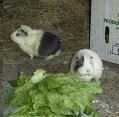 |
Bungala Ridge Permaculture Gardens REDUCE ... REUSE ... RECYCLE ... REPAIR ... RETURN ... REVEGETATE ... REPLENISH |
||||||||
|
|||||||||
|
|
Growing a Forest in our Backyard! Eleven years ago, I watched a series on television about the threat of nuclear war and the polluting effects of nuclear energy. The graphic images haunted me for weeks. This fear ran counter to my optimistic nature and I fought its depressive grip with a stronger weapon - the instinctive need to survive. What could I, an ordinary person with problems of my own, do to change situations decided by greedy and short-sighted governments? I knew I had to do something, bu t that it had to be an affirmative action that supported life, and was non-violent. I joined a peace group dedicated to informing the community about the dangers of nuclear energy. Then fear won another victory. I read a book that detailed the horrors of chemical and biological warfare, which stated that humanity could become victim of a deadly accident due to mismanagement of unnecessary stockpiles of chemical and biological agents. Disturbed by the negative effect these horrifying facts had on me I decided to focus on positive, achievable action. I knew that to remain sane I needed to make a difference where I lived, and set examples my family and friends could emulate. The peace group had introduced me to two wonderful organisations, Permaculture and Trees For Life. Both promoted life-affirming activities and operated at the grass roots level. Dedicated volunteers espouse sustainable visions and work toward changing the way people think about the world. I became hooked, with enough positive action to keep my imaginative brain busy for years. Permaculture is wonderful as a concept, but hard to achieve in practice. It demands a total change in perspective and challenges old values, beliefs and patterns of behaviour. I will never cease to learn about how to live sustainably!Trees For Life, on the other hand, gave me instant success and a feeling that I could, with minimum effort, make a real contribution. A sad journey through thousands of acres of dieback on the New England plateau convinced me that without trees we would quickly loose the delicate balance of life-giving gases in our atmosphere. Permaculture emphasises the interdependence of all life forms, and as it turned out, the trees were dying, not because of one cause, but many, all somehow related to each other. I realised that life would only survive on the Earth's surface if we maintained healthy forests. Thus began our odyssey into tree growing as volunteer growers for Trees For Life. Over the summer months our backyard would turn into a miniature forest as thousands of trees germinated and grew, often as tall as two feet, in boxes of plastic tubes. Everyday we would carefully water, prick out weeds and remove hungry bugs. One year, a box of wattles disliked the mains-water, as it came directly from the Murray River and showed signs of dying. We watered them separately with our precious rainwater , collected for drinking only. They thrived and, over time, we noticed how all seedlings thrived better with a sprinkling of rain. Growing trees isn't a lot of work, but committing up to seven months of each year can be hard. If we le ft "our babies" with someone else for a week, we would worry. It doesn't take long for a forest to die at this stage of life.We've grown trees for farms in the South-East region, the Adelaide Hills, Fleurieu Peninsula, and Kangaroo Island. Every ye ar we grew up to twice the number ordered, by carefully transplanting multiple seedlings, and these we planted ourselves or gave away. In 1988, we purchased and began to revegetate a four and a half-acre property. We continue to plant about five hundred trees and understorey species each year. As our forest grows taller and bushier, it begins to look healthier. Natural regeneration of ground loving species has begun. Our aim is to grow our own small piece of bushland, which we can enjoy with friends, other forest enthusiasts, and local wildlife. When the fear rises strongly within me, and I begin to feel there is nothing that we, as a species, can do to repair or stop the global damage we are causing, I go for a short walk, breathe in the fragrant eucalypt air and listen to the wind in the forest in our backyard.
|
Hot Links!
This site is sponsored by EditRegion2 |
|||||||
|
|
|
|
|||||||




